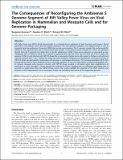Files in this item
The consequences of reconfiguring the ambisense S genome segment of Rift Valley Fever Virus on viral replication in mammalian and mosquito cells and for genome packaging
Item metadata
| dc.contributor.author | Brennan, Benjamin | |
| dc.contributor.author | Welch, Stephen R. | |
| dc.contributor.author | Elliott, Richard M. | |
| dc.date.accessioned | 2014-05-08T14:31:06Z | |
| dc.date.available | 2014-05-08T14:31:06Z | |
| dc.date.issued | 2014-02-13 | |
| dc.identifier | 116754922 | |
| dc.identifier | 27ccdde7-8680-43b6-993e-b4fc3c6d943d | |
| dc.identifier | 000332085900034 | |
| dc.identifier | 84895745384 | |
| dc.identifier | 000332085900034 | |
| dc.identifier.citation | Brennan , B , Welch , S R & Elliott , R M 2014 , ' The consequences of reconfiguring the ambisense S genome segment of Rift Valley Fever Virus on viral replication in mammalian and mosquito cells and for genome packaging ' , PLoS Pathogens , vol. 10 , no. 2 , e1003922 . https://doi.org/10.1371/journal.ppat.1003922 | en |
| dc.identifier.issn | 1553-7374 | |
| dc.identifier.uri | https://hdl.handle.net/10023/4730 | |
| dc.description.abstract | Rift Valley fever virus (RVFV, family Bunyaviridae) is a mosquito-borne pathogen of both livestock and humans, found primarily in Sub-Saharan Africa and the Arabian Peninsula. The viral genome comprises two negative-sense (L and M segments) and one ambisense (S segment) RNAs that encode seven proteins. The S segment encodes the nucleocapsid (N) protein in the negative-sense and a nonstructural (NSs) protein in the positive-sense, though NSs cannot be translated directly from the S segment but rather from a specific subgenomic mRNA. Using reverse genetics we generated a virus, designated rMP12:S-Swap, in which the N protein is expressed from the NSs locus and NSs from the N locus within the genomic S RNA. In cells infected with rMP12:S-Swap NSs is expressed at higher levels with respect to N than in cells infected with the parental rMP12 virus. Despite NSs being the main interferon antagonist and determinant of virulence, growth of rMP12:S-Swap was attenuated in mammalian cells and gave a small plaque phenotype. The increased abundance of the NSs protein did not lead to faster inhibition of host cell protein synthesis or host cell transcription in infected mammalian cells. In cultured mosquito cells, however, infection with rMP12:S-Swap resulted in cell death rather than establishment of persistence as seen with rMP12. Finally, altering the composition of the S segment led to a differential packaging ratio of genomic to antigenomic RNA into rMP12:S-Swap virions. Our results highlight the plasticity of the RVFV genome and provide a useful experimental tool to investigate further the packaging mechanism of the segmented genome. Author Summary Rift Valley fever virus (RVFV) is a mosquito-borne bunyavirus found primarily in sub-Saharan Africa that can infect both domestic animals and humans. RVFV has a tripartite RNA genome that encodes seven proteins. The smallest (S) segment has an unusual ambisense coding strategy whereby two genes (for the nucleocapsid N and nonstructural NSs proteins) are encoded in opposite orientations on the genomic RNA, and are translated from specific subgenomic mRNAs. N is the major structural protein of the virus while NSs is the major virulence factor. To investigate the biological significance of this coding arrangement, we used reverse genetics to create a recombinant virus in which the N and NSs coding sequences were swapped on the S segment. The recombinant virus grew less well in tissue culture cells compared to the parental virus, and rather than maintain persistence in insect cells, infection resulted in their death. In addition, packaging of the modified S genome segment into new virus particles was altered. We also showed that a foreign protein could be expressed to high levels when cloned in place of the NSs gene in the recombinant virus. These studies have implications for vaccine development and vector control strategies. | |
| dc.format.extent | 18 | |
| dc.format.extent | 8147722 | |
| dc.language.iso | eng | |
| dc.relation.ispartof | PLoS Pathogens | en |
| dc.subject | Dependent protein-kinase | en |
| dc.subject | Bunyamwera virus | en |
| dc.subject | NSS protein | en |
| dc.subject | Infected-cells | en |
| dc.subject | Noncoding regions | en |
| dc.subject | Untranslated regions | en |
| dc.subject | RNA interference | en |
| dc.subject | Coding strategy | en |
| dc.subject | Punta-toro | en |
| dc.subject | Expression | en |
| dc.subject | QH301 Biology | en |
| dc.subject | SDG 3 - Good Health and Well-being | en |
| dc.subject.lcc | QH301 | en |
| dc.title | The consequences of reconfiguring the ambisense S genome segment of Rift Valley Fever Virus on viral replication in mammalian and mosquito cells and for genome packaging | en |
| dc.type | Journal article | en |
| dc.contributor.sponsor | BBSRC | en |
| dc.contributor.sponsor | The Wellcome Trust | en |
| dc.contributor.sponsor | European Commission | en |
| dc.contributor.sponsor | The Wellcome Trust | en |
| dc.contributor.sponsor | Medical Research Council | en |
| dc.contributor.institution | University of St Andrews. School of Biology | en |
| dc.contributor.institution | University of St Andrews. Biomedical Sciences Research Complex | en |
| dc.identifier.doi | 10.1371/journal.ppat.1003922 | |
| dc.description.status | Peer reviewed | en |
| dc.identifier.grantnumber | BB/G004277/1 | en |
| dc.identifier.grantnumber | 099220/Z/12/Z | en |
| dc.identifier.grantnumber | 211757 | en |
| dc.identifier.grantnumber | 079810/Z/06/Z | en |
| dc.identifier.grantnumber | G0800161 | en |
This item appears in the following Collection(s)
Items in the St Andrews Research Repository are protected by copyright, with all rights reserved, unless otherwise indicated.

